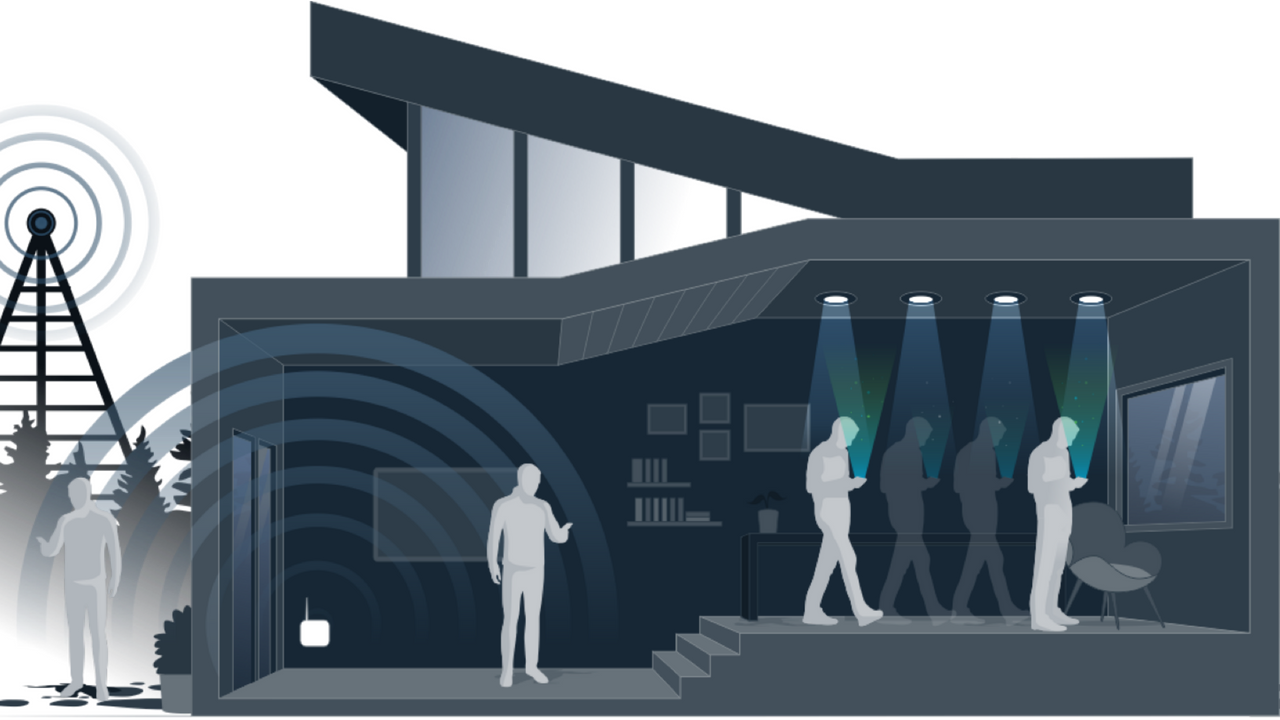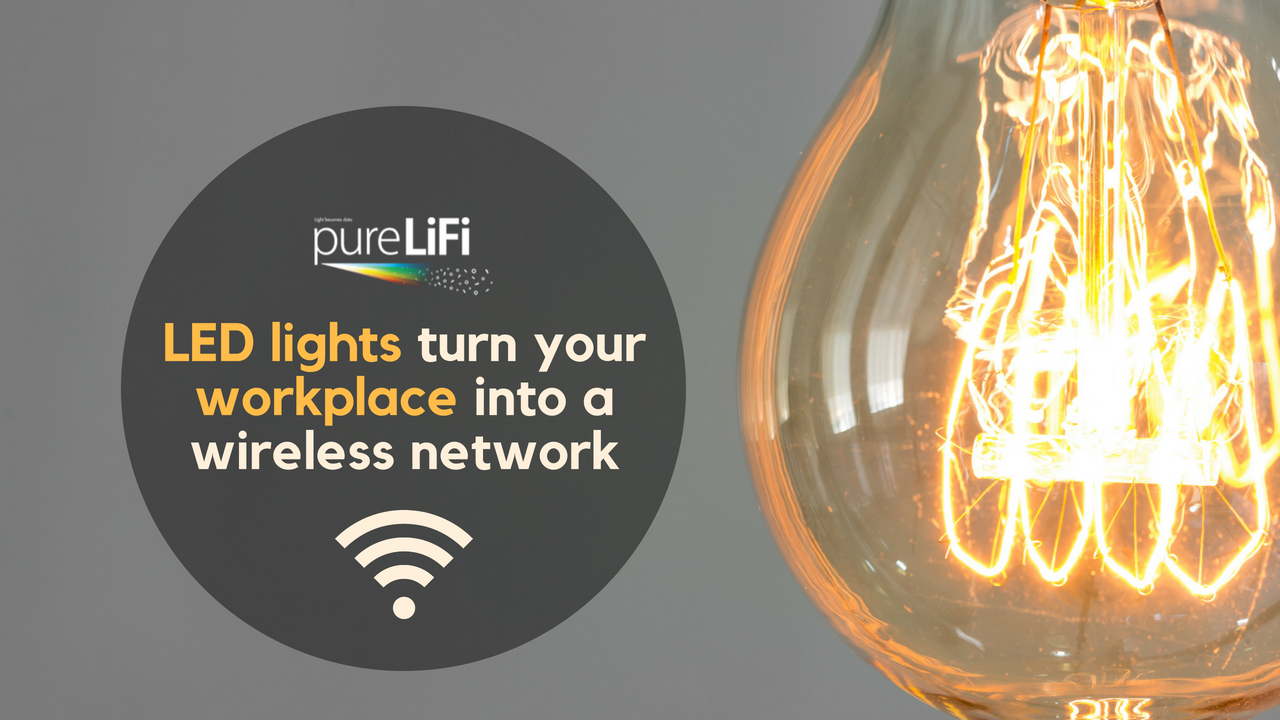- LiFi technology turns your lights into a wireless network
- Benefits include improved security, connectivity and location-based services
- LiFi is expected to be a mainstream product in the next few years
The IoT is a wonderful thing, or so we are led to believe. But how will our (already overstretched) networks cope with an expected 20 billion connected IoT devices by 2020?
This is where LiFi steps in.
LiFi transforms every LED light in your workspace into a high-speed, smart and secure internet access point to provide immersive connectivity in every nook and cranny of your building. In other words, your lightbulbs now provide your wireless network.
How does this work? Well, when an electrical current is applied to an LED light, a stream of photons (aka light particles) is emitted. The brightness of an LED bulb can be changed very quickly, which allows you to send a signal by changing the light intensity. A detector picks up and interprets these tiny changes in light intensity as data.
This change in intensity is so quick that it cannot be detected by the human eye (so you don’t need to worry about flickering lights) and it can work across any light conditions as it’s the change in the light intensity that transmits the data. So, you don’t need to close the curtains for it to work.
And, when you do turn off your lights, your LED lights will still transmit a LiFi signal at a low lighting rate – so your connectivity remains.
pureLiFi is one company developing this technology. Currently, pureLiFi’s technology provides communications at light levels down to 60 lux. For comparison, the British standard for minimum light level for reading is 400 lux. There are also other options for using invisible parts of the light spectrum such as infrared, which is currently already being used for sending information back to the light bulb, according to pureLiFi.
And, if you move away from one light source, your connection will remain as the data rate is not dependent on the line of sight, but on the signal quality at the device. Another LiFi device will step in (or a WiFi network – more on that later).
The installation process is also pretty straightforward and flexible, you just need to use a standard mains power supply and use LED light bulbs.
A range of benefits result. Not only can you use a spectrum more than 1,000 times greater than the spectrum utilized for radio frequencies, LiFi is also beginning to unlock unprecedented data and bandwidth, according to pureLiFi.
Signify (formerly Philips Lighting) is also developing LiFi technology. Speaking in a statement, its Chief Innovation Officer, Olivia Qiu, said: “While radio frequencies are becoming congested, the visible light spectrum is an untapped resource with a large bandwidth suitable for the stable simultaneous connection of a vast array of Internet of Things devices.”
You can also offer a range of location-based services with this technology and provide connectivity to tricky spaces, such as underground basements where WiFi can struggle.
Sounds great, doesn’t it?
But, is LiFi really a feasible solution for a workspace environment? Won’t leaving the lights on just rack up a hefty electricity bill?
Not quite. Jerry Johnson, chairman of the board at turnkey lighting, controls and IoT solutions provider Energy Management Collaborative (EMC), explained: “LiFi is very feasible in an office environment because light fixtures are generally well distributed and the line of sight to lights is typically unobstructed.”
“Power for LiFi is actually considerably less than WiFi power. It has the capacity to transmit information 100 times faster than WiFi making it a more desirable technology for file transfers. Also, data security can be enhanced due to the higher speeds,” Johnson added.
This is an interesting point. LiFi is a containable wireless technology. You just need to close the blinds and your wireless data cannot escape. On the downside, that also means it won’t work if you pop your device in your pocket (unless, maybe, you’re wearing a transparent suit).
This is where traditional WiFi networks can pick up the slack, as Johnson explained: “We envision LiFi co-existing with WiFi. LiFi would focus on indoor positioning, more precise IoT control, critical security tasks and data intensive activity. WiFi would be utilised for lower speed, less precise or secure needs to offload the LiFi system.”

“However, for LiFi to be viable, we need the costs to come down more, which they are, and for our computing devices to add infrared ‘dongles’ until integrated infrared devices are available.”
These barriers to adoption don’t seem unsurmountable. After all, who remembers the WiFi dongles of yesteryear and the days when dial-up networks charged on a per minute basis? With innovation, our gadgets always evolve and widespread adoption means prices eventually come down.
EMC is already trialling this technology. Johnson said: “We have been installing ‘one-way’ LiFi using Bluetooth technology for selected customers.”
One-way LiFi uses light to broadcast information to a device, but it can’t communicate back because devices do not have infrared transmitters built in yet. “You can’t do things practically over the internet with LiFi until it’s truly two-way. Right now, we are installing bi-directional, true LiFi solutions in our lab for full evaluation in the near future,” according to Johnson.
He added: “Our estimate is it will be several years before true LiFi technology will be a mainstream product offering. There is no doubt in our minds though that it will be an integral solution to the IoT revolution.”


 Dr. Gleb Tsipursky – The Office Whisperer
Dr. Gleb Tsipursky – The Office Whisperer Nirit Cohen – WorkFutures
Nirit Cohen – WorkFutures Angela Howard – Culture Expert
Angela Howard – Culture Expert Drew Jones – Design & Innovation
Drew Jones – Design & Innovation Jonathan Price – CRE & Flex Expert
Jonathan Price – CRE & Flex Expert














